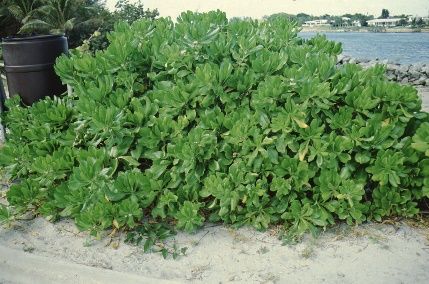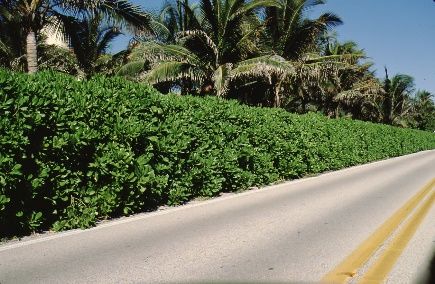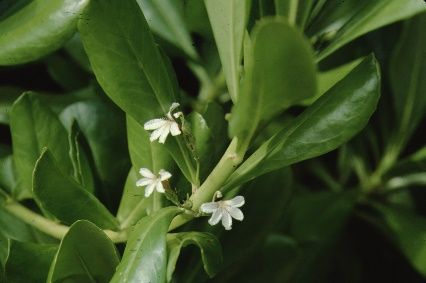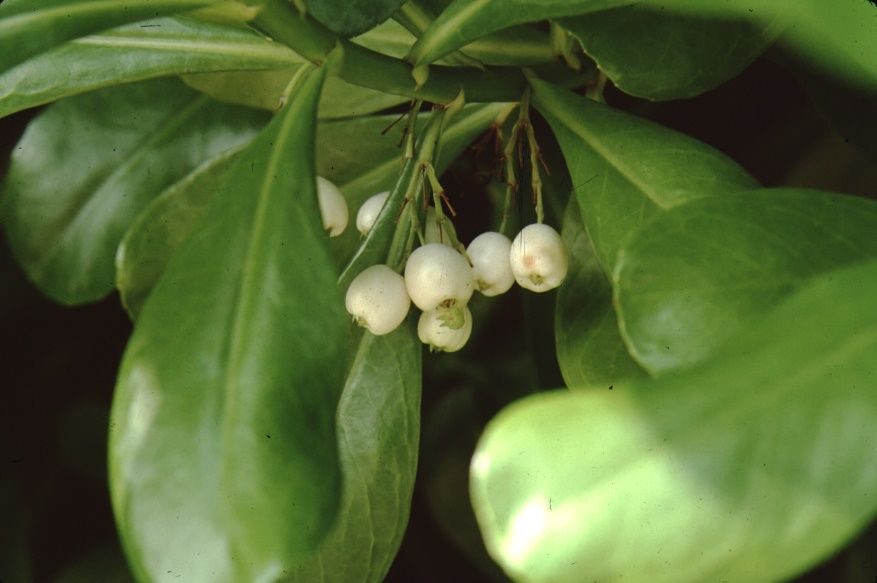Introduction
This loosely rounded to spreading shrub is a robust grower that is commonly 3 to 10 feet tall with an equal spread. The shrubs form rounded clumps where they have been planted along the beaches of south Florida. It has fleshy, bright green leaves that are densely clustered at the tips of the branches. The inconspicuous, axillary flowers of this shrub are borne in clusters of 5 to 9 and occur throughout the year. The individual flowers are white, fragrant, and comprised of only half of a full corolla. The medium-sized fruits of this shrub are white, pithy berries.

Credit: Edward F. Gilman, UF/IFAS

Credit: Edward F. Gilman, UF/IFAS

Credit: Edward F. Gilman, UF/IFAS

Credit: Edward F. Gilman, UF/IFAS
General Information
Scientific name: Scaevola frutescens
Pronunciation: see-VOLE-luh froo-TESS-senz
Common name(s): scaevola, beach naupaka
Family: Goodeniaceae
Plant type: shrub
USDA hardiness zones: 10 through 11 (Figure 5)
Planting month for zone 10 and 11: year-round
Origin: not native to North America
Invasive potential: potentially invasive
Uses: border; mass planting; foundation; small parking lot islands (< 100 square feet in size); medium-sized parking lot islands (100-200 square feet in size); large parking lot islands (> 200 square feet in size); screen; superior hedge
Availability: generally available in many areas within its hardiness range

Credit:
Description
Height: 3 to 10 feet
Spread: 3 to 6 feet
Plant habit: round
Plant density: dense
Growth rate: moderate
Texture: medium
Foliage
Leaf arrangement: spiral
Leaf type: simple
Leaf margin: revolute
Leaf shape: spatulate
Leaf venation: pinnate
Leaf type and persistence: evergreen
Leaf blade length: 4 to 8 inches
Leaf color: green
Fall color: no fall color change
Fall characteristic: not showy
Flower
Flower color: white
Flower characteristic: summer flowering
Fruit
Fruit shape: oval
Fruit length: 0.5 to 1 inch
Fruit cover: fleshy
Fruit color: white
Fruit characteristic: showy
Trunk and Branches
Trunk/bark/branches: not particularly showy; typically multi-trunked or clumping stems
Current year stem/twig color: green
Current year stem/twig thickness: very thick
Culture
Light requirement: plant grows in part shade/part sun
Soil tolerances: alkaline; sand; acidic; loam
Drought tolerance: high
Soil salt tolerances: good
Plant spacing: 36 to 60 inches
Other
Roots: sprouts from roots or lower trunk
Winter interest: no special winter interest
Outstanding plant: not particularly outstanding
Pest resistance: very sensitive to one or more pests or diseases which can affect plant health or aesthetics
Use and Management
Scaevola makes a great screen or hedge and is also useful as a tall ground cover along the beach. This plant is good for erosion control and may be used as an informal hedge or clipped hedge. It is suited for planting along a foundation if the soil drains well.
Scaevola will adapt to any soil and responds to irrigation and occasional fertilization with rapid growth. However, it also thrives on neglect. This shrub flourishes with high levels of sunshine and ocean spray, and it will grow well on marl land or on beach dunes. It has invaded some coastal locations adjacent to where it was planted. It becomes much larger than the native Scaevola plumieri.
The propagation of scaevola is accomplished by the use of cuttings.
Pests and Diseases
Chewing insects may be troublesome to scaevola, and mites may be a serious problem.